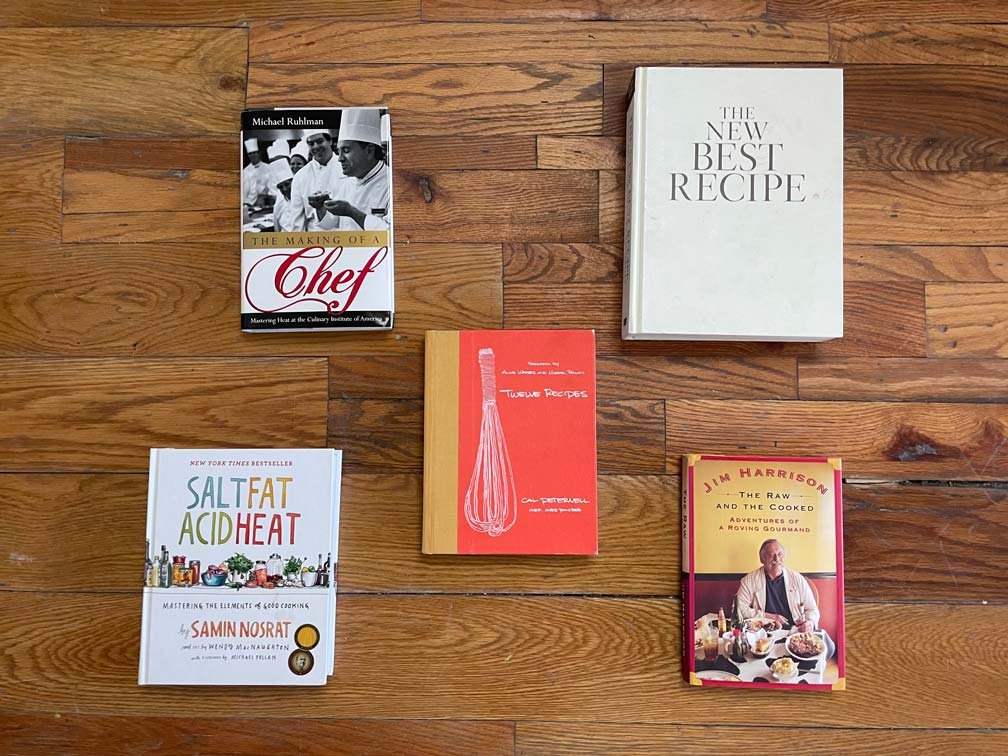Especially in the COVID era, I feel lucky to have grown up in a household where cooking was enjoyed. After knocking off from the office, my Dad had dinner on the table for the family like clockwork. Now that I'm a father myself I appreciate more than ever how difficult that can be, but striving to keep things simple goes a long way in the kitchen. Taking pleasure in regular practice while feeding yourself and others is immensely satisfying, and at the end of the day, rather than succumbing to the allure of endless scrolling, paging through the chapters of a cookbook can be a savory past time. I tend to prefer volumes that are long on personal insight rather than those that aspire toward encyclopedic inclusiveness. I'm also a sucker for a genre I call "spreads," books that pair a beautiful picture on one side with a single page recipe description on the other.
Formatively, I’ve got an anthology of classic Italian recipes from my Great Grandma Jo, and another set of vintage American dishes from my Grandma Lila. By now I’ve worked my way through a good number of both, but I didn’t properly begin my own adventures in cooking until I met my wife. While our courtship lasted the better part of a decade, it was rich with everlasting meals and culinary adventure. Along the way I went from being able to turn out only half a dozen bachelor staples, to mixing and matching steps from multiple recipes whenever the mood for cassoulet or curry strikes. As the years have passed, I've moved through countless plates courtesy of Epicurious, Food52, and the NYTimes Cooking App, but really nothing beats the editorial selection bias in a good cookbook. At this point, my library has grown unruly, but there are a few trusty friends I find myself constantly referencing from both necessity and simple pleasure.
Book Recommendations
12 Recipes Either Cal Peternell’s first book found me at the right time in my cooking history, or it really is simply the best primer for elevating your cooking intuition. Ostensibly written as a book of straight forward cooking advice for his son, this book cultivates a great set of skills that accumulate over the course of the chapters. 3 types of toast?!? Who knew that could change your life. Pasta otherwise? Yes please… This book has the most reassuring tone of playful utility in the kitchen and probably contains the highest ratio of “actually cooked” meals of any volume I’ve ever purchased.
The New Best Recipe As far as reference books go, the folks at Cook’s Illustrated created one of the clearest and most beautifully designed manuals imaginable. The prose is clean and direct. The accompanied images provide detailed context and the organization of the material progresses logically. The recipes are explained in depth along with the reasoning behind the test kitchen’s decision making. Working through this book in its entirety would certainly make for a thorough kitchen education, but I find opening it at random and just reading for a few minutes to be incredibly calming.
Salt, Fat, Acid, Heat Samin Nosrat’s masterpiece of a debut is really two books in one. The first half is a literary exploration of her philosophy of cooking, while the second contains recipes for practical and delicious treatments of a wide variety of dishes. Numerous vividly useful illustrations are also strewn throughout the pages, each forming a sort of cuisine matrix: wheels of ingredients, flavor maps, salting timelines and kitchen workflows.
The Making of a Chef Michael Ruhlman’s first memoir is a freshly detailed account of a year’s work at the Culinary Institute of America. It’s the sort of hyper-articulate immersive journalism I love, but more than that, it’s a playbook for any aspiring cook. The notes on stock making and knife technique alone are worth the price of admission. An everyman’s journey from diner denizen to haute cuisine enthusiast.
The Raw and the Cooked Jim Harrison’s incredible collection of articles has been an inspiration for years. As a former midwesterner, I feel strongly attached to Harrison’s descriptions of wild country cooking. For a roving gourmand, there’s no one better to take a cue from. Countless phrases could be mistaken for aphorisms if they weren’t so distinctly Harrison in tone. It’s a book best read with a good glass of wine in hand while a pot is long simmering on the stovetop. A legendary appetite for indulgence is captured in fine form, and nothing feeds the soul like a shameless meal.
